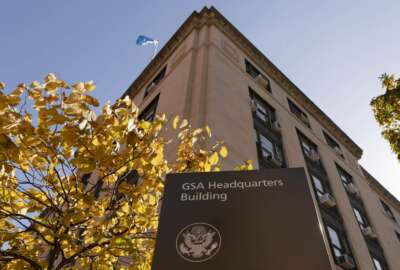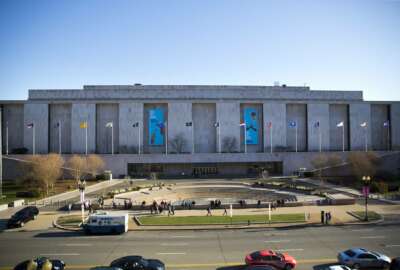
NSA’s National Cryptologic Museum gets new director
The popular National Cryptologic Museum has been closed to the public, but it hasn't been static. It's acquired new exhibits and is planning to relocate into a new...
Best listening experience is on Chrome, Firefox or Safari. Subscribe to Federal Drive’s daily audio interviews on Apple Podcasts or PodcastOne.
The popular National Cryptologic Museum, like so many others, has been closed to the public. But it hasn’t been static. It’s acquired new exhibits and is planning to relocate into a new National Security Agency location, still on the drawing boards. And it has a new director. Dr. Vince Houghton joined Federal Drive with Tom Temin with the latest.
Interview transcript:
Tom Temin: Dr. Houghton, good to have you on.
Dr. Vince Houghton: It’s great to be here Tom. Thanks.
Tom Temin: And you came from the National Spy Museum, correct?
Dr. Vince Houghton: Yeah, the International Spy Museum. I had been there for six and a half years, we went through the process if you’re around DC of standing up a new building ourselves. And that was a big part of what I could kind of sort of accomplishment. Is that move from downtown DC to the L’Enfant Plaza area.
Tom Temin: So are you a museum guy, a cryptologic guy, a criminal guy or a national security guy?
Dr. Vince Houghton: Probably the national security side, my PhD is in intelligence history. I didn’t know much about museums when I went to the International Spy Museum for the first time, but I got a crash course on the job training as we built the new museum. And after six and a half years, I guess I resist the urge to call myself a museum guy, but I think it’s inevitable at this point. I’m clearly a museum person now.
Tom Temin: Well, I would say that a specialized museum like that takes a good deal of intellectual rigor to keep it on track. So your background probably comes into play quite a great deal.
Dr. Vince Houghton: One of the extraordinary things about the spy museum is how broad the content is. It’s not just American intelligence. It’s international intelligence. Like right now I’m dealing with cryptology with signals intelligence. That was everything. And everything, not just recent, but going back as far as you possibly can. There’s advantages and disadvantage of that. Now I’m in a position where I can really hone in on the cryptologic history on the history of signals intelligence, and what the NSA does. And it’s refreshing at the same time as it is a whole new ballgame.
Tom Temin: And tell us what’s been going on while the Cryptologic Museum has been closed to the public, in particular, some of the new exhibits that you’ve acquired for when people can come back.
Dr. Vince Houghton: We’re not sitting on our hands while COVID is causing chaos throughout the country. We’re trying to do everything we possibly can to make sure that the Cryptologic Museum stays in people’s minds. And then when we are able to reopen that people want to come back because they’re excited about what they can possibly find here. We’ve been continuing virtual programming. And that’s something that we haven’t stopped doing. Virtual programming is available almost every day of the week, both for students and for adults. And we’ve continued to try to acquire new artifacts and new exhibits. One thing that we’ve recently acquired was part of the bottom complex model that NGA made, this great relationship between intelligence community, museums and outreach. And people are just now learning about the NSA contribution to the raid to get Bin Laden. And because of that, we’re able to show this. We wouldn’t be able to otherwise. So it’s great that things are beginning to become more declassified to where we can start to show the public, both people who are casual visitors and people who really care about cryptologic history about the NSA contribution to missions that you wouldn’t necessarily think are part of NSA’s purview.
Tom Temin: And just to let people know, the Abbottabad complex is where Bin Laden was living at the time of his discovery and elimination by US forces.
Dr. Vince Houghton: Yeah, absolutely. And I think that the narrative for the last 10 years or so since the mission took place was it was Navy Seals, it was CIA, there’s a movie made about CIA’s contribution to that. And I think that recently, people have been surprised to find out how NSA was a component in that as well. And because that has become made public, we’re able to work with NGA to get this model that we’re going to have on display. And people will be able to see it virtually at first. And then of course, when we reopen, they can come look at it firsthand.
Tom Temin: And of course, the museum famously has some of the crypto-logical equipment from World War II, this electromechanical with wheels and buttons and dials and so forth. As we get deeper into the 21st century, and cryptology and spy craft is often invisible, because it’s embedded in electronics. Does that present a challenge for finding new artifacts because you can’t see a cryptographic algorithm?
Dr. Vince Houghton: Yeah. I mean, there’s always the question about as things become less three dimensional, as things become less touchable, how do museums move forward in the digital world? And I think that certainly presents a challenge, but we’re working on finding ways around it. I mean, there’s still three dimensional objects involved, even in the world of cyber. And that’s something that it’s a bit of a come to Jesus moment for a lot of museums that deal with this. The spy museum had to think about this as well, about how do we get this point across to the public when you have things that are, like you said, algorithms versus actual three dimensional artifacts. But there’s still means to do that. A lot of museums nowadays, whether they’re government museums or otherwise have interactives, have digital, the walls moving digitally, but token museums, and that gives us an opportunity to do things that we couldn’t do otherwise. So we’re looking forward to presenting that story, that narrative to the public, as well as the whole history of cryptologic history which goes back to the beginning of time.
Tom Temin: Well, I like to still pretend that my cufflinks are tiny cameras sometimes. Tell us about the new location, where that is, what’s going on and the status of it.
Dr. Vince Houghton: The new locations kind of an interesting, we’re not moving far, basically across the parking lot. The building that is planned will be an extraordinary building. It’ll be a cyber center education and innovation. We’re looking at trying to bring together a lot of different aspects of what NSA does, of what cryptology is in a bigger picture, so that our visitors will be able to learn a lot about what the cyber world has to offer. Both what NSA does, but also in a broader sense about the new environment that we’re in. And that museum will be inside of that larger building. And we’re really looking forward to this opportunity to take what is now an extraordinary museum, and bring it into the 21st century, that’s really what we’re looking to do. And with the resources that we’re going to have, with the ability to go out and collect new artifacts, and go out and tell stories as they become declassified, we’re really looking forward to what the future is bringing.
Tom Temin: And so this is not broken ground yet. So it’s gonna be a little while till you actually move across that parking lot.
Dr. Vince Houghton: Yeah, absolutely. I know, you think hey we’re moving about 50 feet across the parking lot, it shouldn’t take much time. But we’re not trying to rush this. Obviously we want to get this stood up because we’re excited about the possibilities it brings us. We want to make sure we do this right, and we want to make sure that we can have a museum that will be available to the public for decades to come. And one of the goals that we have, if anyone’s been to the Cryptologic Museum, we’re off the beaten path a little bit. We’re on the way from DC to Baltimore, but we want to be a true destination. We want to be a place where people who visit DC who have done this Smithsonian’s and everything else say, you know what we’re happy to make the drive out to Udvar-Hazy, which is basically the same distance as we are. But people don’t think about us that way. And that’s where the new building provides us with that opportunity to say, you know what, this is an amazing museum. Let’s drive up to Fort Meade and see what it has offer.
Tom Temin: And we should remind people, you don’t need to go through the security gates to get to the museum, correct?
Dr. Vince Houghton: Yeah, absolutely. We’re outside the fence line. We’re actually the only museum that is run by the intelligence community that is open to the public. So yes, the other agencies have wonderful museums that used to get special permission to go into CIA to see the CIA museum. Anyone and everyone can come to the Cryptologic Museum. We are outside the wire. And you don’t need any kind of clearance. Just come check us out.
Tom Temin: Dr. Vince Houghton is director of the National cryptologic Museum. Thanks so much for joining me.
Dr. Vince Houghton: It’s been a pleasure. Thank you.
Copyright © 2025 Federal News Network. All rights reserved. This website is not intended for users located within the European Economic Area.
Tom Temin is host of the Federal Drive and has been providing insight on federal technology and management issues for more than 30 years.
Follow @tteminWFED
Related Stories





